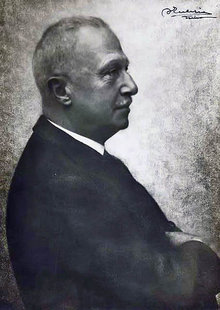Difference between revisions of "Giovanni Agnelli"
m |
m |
||
| (3 intermediate revisions by the same user not shown) | |||
| Line 1: | Line 1: | ||
{{X}} | {{X}} | ||
| − | {| border=1 | + | {| border=1 cellspacing=3 cellpadding=4 style="float:right; margin:0 0 .5em 1em; width:220px; background:#505050; border-collapse:collapse; border:1px solid #999; font-size:83%; line-height:1.5; " summary="Infobox Automobile" |
| − | |- | + | |- style="text-align:center; background:#505050;" |
| − | |colspan=2|[[Image: | + | | colspan=2 style="padding:0; background:#333333; color:#fff; border-bottom:1px solid #999;" |[[Image:425px-Giovanni_Agnelli.jpg|220px]] |
| − | |- | + | |- style="color:#fff; background:darkred; font-size:larger;" |
| − | + | ! colspan=2 |'''Giovanni Agnelli''' | |
|- | |- | ||
|Birth date || [[13 August]] [[1866]] | |Birth date || [[13 August]] [[1866]] | ||
Latest revision as of 18:20, 22 February 2009

| |
| Giovanni Agnelli | |
|---|---|
| Birth date | 13 August 1866 |
| Birth place | |
| Death date | 12/16/1945 |
| Nationality | |
| Known for | Fiat |
Giovanni Agnelli (13 August 1866 - 16 December 1945) was an Italian entepreneur, who founded Fiat car manufacturing in 1899.
Early life
The son of Edoardo Agnelli and Aniceta Frisetti, he was born in Villar Perosa, a small town near Pinerolo, Piedmont, still the main home and burial place of the Agnelli family. His father, mayor of Villar Perosa, died at age 40, when Giovanni was just five. He studied at the Collegio San Giuseppe in Turin; then embarked on a military career until 1893 when he returned to Villar Perosa, where he followed in his father's footsteps and became mayor in 1895 which he held until his death. Agnelli heard about the invention of the (then) new horseless carriage and immediately saw an opportunity for using his engineering and entrepreneurial skills. In 1898, he met Count Emanuele Bricherasio di Cacherano of Turin, who was looking for investors for his horseless carriage project; Agnelli sensed the opportunity.
Business career
On July 1, 1899 he was part of the group of founding members of the Fabbrica Italiana di Automobili Torino, which became Fiat; he paid $400 for his share in 1899, worth billions today. One year later he was the managing director of the new company and became the chairman in 1920. The first Fiat plant opened in 1900 with 35 staff making 24 cars. Known from the beginning for the talent and creativity of its engineering staff; by 1903 Fiat made a small profit and produced 135 cars; this grew to 1,149 cars by 1906. The company then went public selling shares via the Milan stock exchange. Agnelli began purchasing all the shares he could adding to his holding, overcoming scandals and labour problems. After World War I the company jumped from 30th to third place among Italian industrial companies. The first Ford factory was opened four years after Fiat was founded and Agnelli visited several times and adopted various practices he observed. He was appointed a Senator in 1923, and filled several other prestigious positions between the two wars. However Agnelli remained focused and propelled Fiat to the international arena. He was still active with FIAT at the start of the Second World War, but died soon after it ended in 1945 at age 79.